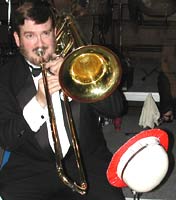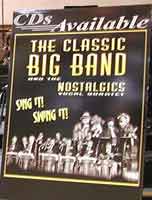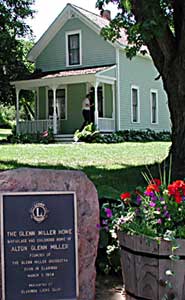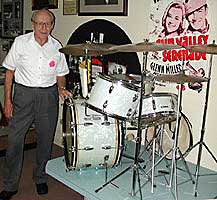
Glen Newton plays bass trombone at the Saturday night dance; note the red-and-white hat mute in the foreground
The following article by Glen Newton appeared in Strutters Quarterly, Vol. 13, No. 3, Summer 2003, pp. 6, 26, and 27. Some of the pictures that accompanied the article are shown here; others are shown along with other information about the Classic Big Band at the 2002 Glenn Miller Festival.
Each June, the Glenn Miller Birthplace Society presents a festival in Clarinda, Iowa, honoring Miller and featuring entertainment from all over the world. One of the highlights of the extended-weekend festival is the Saturday night dance, and last year I was part of the entertainment for the dance.
Dr. Dan Odegaard, leader of the Twin Cities’ own Classic Big Band, had been invited to bring the band to the festival for the second year in a row — a rare honor. I’d played with the group previously, and when the bass trombonist had a conflict that weekend, Dan asked me to fill the bass trombone chair.
We left from the Richfield Legion parking lot at 8:10 a.m. I’d planned on sleeping on the way down, but it was so interesting talking with other band members, seasoned musicians with many interesting stories to tell, that I got little rest. We arrived in time to check in to our hotel, eat dinner, and walk around the town a bit before taking the bus to the high school to set up for the dance.
The dance lasted from 8:00 p.m. until midnight. By 7:30, the line at the door was impressive as dancers queued up to get in and not miss a note of the music!
We started out with Miller’s theme song, Moonlight Serenade, and the dance floor was packed! At the end of an abbreviated version of the song, we segued into Stardust, the song that radio station KLBB’s Greatest Hits List pegs as the #1 hit song of all time. After the band played Tuxedo Junction, the Nostalgics vocal quartet made their first appearance, singing Make Believe Ballroom Time.
The dancers and listeners all seemed to be having a good time, and I know part of that was the nostalgia of hearing the same arrangements that the great bands played in the 1930’s. One of the unique attributes of the Classic Big Band is the historic repertoire, which Dan has carefully collected from various sources.
A comment from Bill Kotrba will give you an idea of how unusual this is. Bill played lead tenor sax with the Glenn Miller ghost band under Larry O’Brien for several years, filling the Tex Beneke role as both saxophonist and singer. He noted that the Classic Big Band has one or two of the Miller band arrangements that the Glenn Miller ghost band doesn’t!
You might wonder what presents the greatest difficulty in performing the Miller arrangements. One thing is the requirement for excellent clarinet playing. Miller counted on it, and yet few modern bands can match his demands. Fortunately, the Classic Big Band has several top-notch clarinetists, with the list headed by lead alto sax/clarinetist Bob Dean, whose playing on songs like Take It conjured up memories of Artie Shaw and other big band greats.
Another difficulty for trombonists is really a blessing. Miller often featured the trombone section, so we’re expected to stand to play choruses in selections like Alice Blue Gown and Wonderful One, the band’s two waltzes of the evening. For the members of the original Miller band, there was plenty of rehearsal time to spend memorizing the parts, but for those of us who play the music less frequently, it means figuring out how to look down at an angle to the music far below while pointing the horn out at the audience.
 Glen Newton plays bass trombone at the Saturday night dance; note the red-and-white hat mute in the foreground |
Perhaps the greatest difficulty for the trombone section is the requirement to change mutes quickly. To understand the problem, first consider the trumpet player who makes a mute change. He or she holds the trumpet with the right hand, both supporting the instrument and fingering the notes with that hand, while fetching and inserting the mute with the left hand. The poor trombonist, however, needs both hands to play his horn because note changes are made with a slide rather than valves. This means that before the trombonist can reach for a mute, he must return the slide to home position, so that one hand can grab both the slide and the rest of the horn, freeing the opposite hand to grab the mute. Ah, if it were only that simple! Often, Miller arrangements require the brass player to remove one mute, then quickly insert the next (or grab a hat or plunger mute to wave in front of the bell). And what happens to that discarded mute? Try as one might to set the mute down neatly, it’ll often tip over and roll off to the side or under the chair. That makes it much harder to find when you need the first mute later in the same song! |
Another challenge applies to all sections of any band trying to recreate the sounds of Miller, Dorsey, Shaw, and other giants of the big band era. That’s the problem of getting the right feel, through a combination of articulation, phrasing, tone, tempo, dynamics, accents, and other subtler components of any musical performance. For this challenge, the Classic Big Band is fortunate to have Dan Odegaard as its leader, because he’s studied the performance practices of the era and coaches the band in getting just the right sound. For example, at one rehearsal, we worked on the fine points of the “doo-wah” plunger muted backgrounds that are so common in Miller band arrangements. In recognition of his expertise, Dan was selected to lead the Glenn Miller Birthplace Society Big Band.
Smiles on listeners’ faces told me that the audience enjoyed the creativity of the Classic Big Band soloists, including Bill Kotrba on tenor sax, Steve Supoci on trombone, and all of the vocalists. The band is fortunate to have capable soloists in every chair, and everyone was featured during the evening. For this dance, my modest contribution to the solo lineup was a four-bar bass trombone solo on Dardanella, one of the two Latin selections the band played.
Perhaps my most memorable contribution to the evening’s entertainment came unintentionally during the horn moves on In the Mood. It’s traditional for the trombone players to point their horns in four different directions while sustaining the notes at the phrase endings in the last half of the song. The direction is left to the player’s discretion and changes with each phrase. To give myself more room, I stepped out to the side and moved slightly forward, forgetting about the six-inch riser that elevated the trombone section above the four-foot basic stage height. As my foot slipped over the edge of the riser, I lurched forward, still playing, barely catching myself in time to avoid tumbling off the stage. Later, Larry Thomas, a Twin Cities swing dance aficionado who was dancing near the stage, told me he’d braced himself to catch me if I went over the edge. Thanks, Larry!
| The band’s three breaks gave the dancers a chance to pore over Miller memorabilia on sale in the lobby and to look at the band’s new CD, Sing It! Swing It!, which was first offered for sale at this dance. (See Strutter's Quarterly Vol. 13, No. 1, Fall 2002, for a review of the CD.) |  |
 |
On Sunday after breakfast, the band members visited the Glenn Miller birthplace. This small shrine to Glenn Miller includes artifacts like the Miller band’s first gold record, Chattanooga Choo Choo, indeed the first gold record ever issued. One of the plaques at the entrance to the property identifies the house as “A landmark of American music: Birthplace of Glenn Miller, 1904-1944, internationally known as an orchestrator and director of dance bands.” |
| Glenn Miller's birthplace |
As we were leaving, the curator asked if we’d like to see Glenn Miller’s trombone. Trombonist Jimmy Priddy, who had played under Miller had played Glenn’s trombone professionally for many years, and when he retired, he donated it to the Glenn Miller Birthplace Society.
Each of the band’s trombonists got a chance to play the horn, even using the original mouthpiece that has “Glenn Miller” stamped on it. (You can see more pictures of Glenn Miller’s trombone on the web. Type “Glenn Miller’s Trombone” into Google or another search engine.)
| We also visited the Clarinda museum, which includes more information about Glenn Miller and his bands, as well as items of general historical interest. Of particular interest to drummers is the drum set that Moe Purtill played in the Miller band. |  |
| Classic Big Band drummer Dick Reimer with Moe Purtill's drum set |
The Sunday afternoon picnic, the final event of the festival, has the potential to be the most nerve-wracking performance of the festival, because by then the other musicians have finished their gigs and are free to come relax and watch you. If you’re worried that the pros in the audience will nit-pick your playing, it can affect your confidence and make itself heard in your performance.
I’m happy to report that during the entire two-hour indoor picnic, there was no sign that any of my Classic Big Band colleagues were negatively impacted by the presence of the outstanding musicians in the audience. Indeed, when I scanned the audience, I could see that all, from non-performers to professional instrumentalists and vocalists, were having a good time, just as we were enjoying playing for them.
One perk of playing in the band is that you get to go to the head of the food and drink lines, so you can get back to the stand after your break. This was especially handy because the large attendance at the picnic led to long lines. Even though we dressed less formally for the picnic, people recognized us as members of the band and were gracious about giving us letting us cut ahead of them in line.
Even though it was an indoor picnic, there was dancing room in front of the band, and several couples took advantage of it to swing to the band’s selections.
After the picnic, we packed up the bus and headed back to the Twin Cities, arriving at the Richfield Legion around 2:30 a.m. I felt that in some small way I had helped carry on the legacy of Glenn Miller’s music.